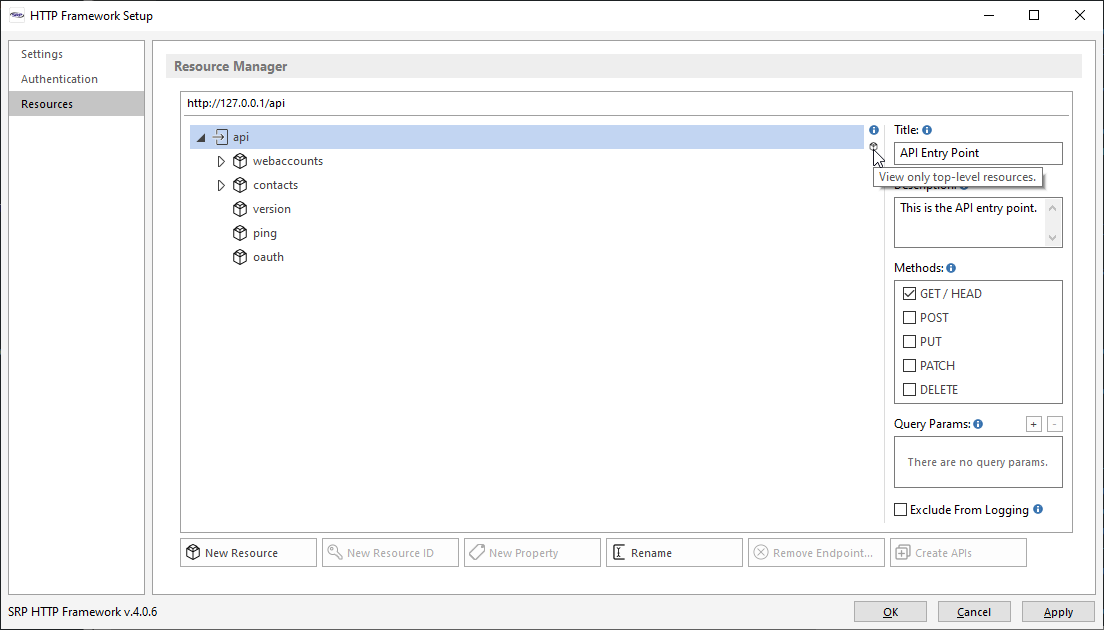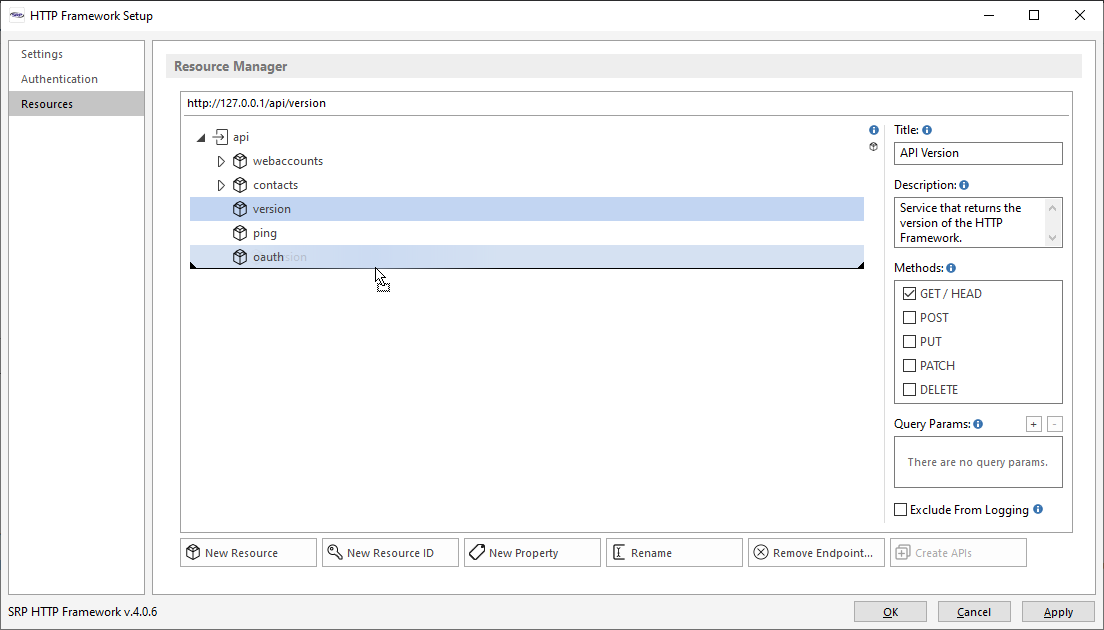Page History
| Table of Contents |
|---|
4.0.
...
10
2023-09-04
OECGI 4.0.2 Love
In older versions of the OECGI, if a developer wanted to capture the values of request headers that were not automatically included in the Request array, a comma delimited list of these headers needed to be entered into the Registry AdditionalValues string. As of OECGI 4.0.2, an asterisk character (*) can be entered instead. This puts all request headers into the Request array. All relevant services within the HTTP_Services module have been updated to be backwards and forward compatible.
Baking More Cookies
In v4.0.7 we provided a GetCookies and a GetCookie service in the HTTPClient_Services module. This was all well and good when handling API requests to other servers, but what about those cookies that were returned to your own APIs? Worry no more because we now have a GetCookies and GetCookie service in the HTTP_Services module to make it much easier to eat those tasty morsels.
What About Blob?
Sending a binary object to another server via a HTTP request doesn't always work. We have added a new argument, ResponseIsBinary, to the SendHTTPRequest service (a member of the HTTPClient_Services module) to force the a "blob" datatype. Note, this requires SRP Utilities 2.2.6 or higher.
4.0.9
2020-07-08
IP Banning
As a compliment to the existing Whitelisted IPs feature we now offer an option to Banned IPs:
4.0.8
2020-03-04
OECGI4.php Love
Perhaps you don't know this, but Revelation Software provides two plug-ins for HTTP connectivity. The original and most likely used is OECGI4.exe (or OECGI3.exe for older systems). This is obviously designed for Windows web servers. The other version is OECGI4.php (and there is also an OECGI3.php). This version would be the plug-in of choice for non-Windows (usually Linux) based web servers. We installed the PHP version several years ago on a few sites and experienced no issues with it. However, a customer recently brought to our attention that their HTTP responses were coming back with the headers appearing with the body. Not good! Upon review and with some insight from the ever helpful Bryan Shumsky, we discovered that the PHP plug-in expects the response headers to be separated from the body with LF as the delimiter. The HTTP Framework has been using CR/LF as the delimiter all this time. There is a reason we use CR/LF delimiters...because this is what the HTTP specification requires. What we didn't know was that the PHP plug-in parses our response (expecting LF delimiters) and then builds a property response using PHP functions. Since we were using CR/LF delimiters, the parsing logic failed and kept the header and the body together. This isn't an issue for OECGI4.exe because it basically passes through the response "as is". Did you get all that? TL;DR: The HTTP Framework now checks to see if the EXE or PHP plug-in is being used and sends back the response using the correct delimiters.
4.0.7
2020-02-27
C is for Cookie, That's Good Enough For Me
Cookies have long been a valuable tool for maintaining state, implementing authentication, and tracking history with web applications. The SRP HTTP Framework has always supported cookies via the SetResponseHeaderField service (a member of the HTTP_Services module) and the GetResponseHeaderField service (a member of the HTTPClient_Services module). However, a recent project convinced us that Cookies needed a little first-class citizen love. Therefore we have added a few new services so baking and consuming cookies is much yummier:
- SetCookie (a member of the HTTP_Services module) - Adds a Set-Cookie header to the response using the indicated Name. The cookie's value and optional attributes will automatically be included as indicated by each argument.
- GetCookies (a member of the HTTPClient_Services module) - Returns all cookie strings from the response headers.
- GetCookie (a member of the HTTPClient_Services module) - Returns the value for the indicated cookie name.
4.0.6
2020-02-04
FrameWorks Friendlier
The SRP HTTP Framework has always been included with the full SRP FrameWorks package. However, the core forms (e.g., HTTP Framework Setup, Web Accounts, and HTTP Logs) were never designed with the intent of running in parallel with the main SRP
FrameWorks Friendlier
The SRP HTTP Framework has always been included with the full SRP FrameWorks package. However, the core forms (e.g., HTTP Framework Setup, Web Accounts, and HTTP Logs) were never designed with the intent of running in parallel with the main SRP FrameWorks MDI Frame. A client reported to us that after running our SRP HTTP Framework forms, their main MDI Frame stopped responding to clicks in the Ribbon control. We identified the problem being related to a memory cache conflict. SRP HTTP Framework now uses its own cache and so the two systems are playing nicely with each other again.
...
- Resource Collapse. The hierarchical resource view can tend to get very busy when multiple resources are open. There are times when we just want to collapse everything to avoid excessive scrolling up and down. A new (fairly inconspicuous) button has been added to do just that:
- Resource Sorting. When new resources are added, they always land at the bottom. However, there are times when we simply want to view our resources in a different order than when their creation date. Now this can be accomplished with a simple drag-and-drop action (shame on us for not adding this sooner)!
...
Don't lose your HEAD
HEAD is one of the first methods introduced in the HTTP spec, but it is probably one of the lesser known members. According to the specification, HEAD works exactly like GET but it does not return a body. So, why would anyone use it? First, it is a way to "test the waters" of a GET request without the overhead that this request might produce. Second, HEAD requests are supposed to return the same HTTP Response headers that a GET request, making it easier to anticipate how the body will be returned (e.g., the Content-Type header should still have a valid value, even if the body is empty). Finally, since the HEAD method requires authentication, it is a great way to "log into" an application without requiring the app to download and endpoint's resource right away. So it seemed time that the SRP HTTP Framework finally give some respect to this often overlooked method.
You may have noticed in the previous screen shots that the GET method displays the HEAD method next to it. This is to indicate that GET and HEAD methods will be enabled or disabled together. Furthermore, all API routines will automatically get a HEAD API signature added above the GET API signature:
| Code Block | ||
|---|---|---|
| ||
////////////////////////////////////////////////////////////////////////////////////////////////////////////////////////
// Endpoint Handlers
////////////////////////////////////////////////////////////////////////////////////////////////////////////////////////
API contacts.HEAD
API contacts.GET
Method = HTTP_Services('GetHTTPRequestMethod')
// If the GET method then return a body. If the HEAD method then just return response headers.
.
.
.
.
end api |
URL Templates and HAL
URI Templates (URL Templates going forward) were introduced in 2012 as a way of documenting the structure of a URL (including any query params). One primary purpose for URL Templates is for "the discovery of available services". This fits very well with the REST constraint of "resource identification". Simply put, a URL Template is an abstraction (or generic version) of a resource URL. A templated version of a URL contains arguments surrounded by curly braces like so:
...
The HAL specification supports links to URL Templates (versus resource links). To help support URL Templates, the AddLinkRelation service (a member of HTTP_Resource_Services) has been updated with new arguments to make it easy to include a URL Template. Any valid resource URL within the system can be passed into the URL argument and if the IsTemplate argument is can be passed into the URL argument and if the IsTemplate argument is set to 1, then it will be converted to a URL Template. For example, the SRP HTTP Framework automatically ships with a Contacts resource which can be accessed via this URL:
https://www.examples.org/api/contacts
There are three query params supported by this resource: first_name, last_name, and state. If the above URL is passed into the AddLinkRelation service with the IsTemplate argument set to 1, then it will be converted to a URL Template. For example, the SRP HTTP Framework automatically ships with a Contacts resource which can be accessed via this URLresulting URL will look like this:
https://www.examples.org/api/contacts
There are three query params supported by this resource: first_name, last_name, and state. If the above URL is passed into the AddLinkRelation service with the IsTemplate argument set to 1, then resulting URL will look like this:
https://www.examples.org/api/contacts{?first_name,last_name,state}
.org/api/contacts{?first_name,last_name,state}
The act of converting a URL Template into a valid resource URL is called "expansion". This is something a consumer of your services might consider building. However, at a minimum, any human agent can review the URL Templates you provide and benefit from self-documenting APIs...which is a major objective of REST!
Embracing SRP Utilities 2.1
The most recent release of SRP Utilities includes many handy services. The SRP_DateTime function, in particular, has been incorporated into the SRP HTTP Framework. We are using it to replace all calls to Utility_DotNet("TIMEZONE") as a way of producing a UTC date/time stamp. We discovered that in some cases Utility_DotNet is unable to return the proper local time which results in a Get_Status() error...which then leads to 502 Bad Gateway errors. Ouch! Suffice to say that the SRP HTTP Framework 4.0.6 requires SRP Utilities 2.1.The act of converting a URL Template into a valid resource URL is called "expansion". This is something a consumer for service might consider building. However, at a minimum, any human agent can review the URL Template your provide and benefit from your self-documenting APIs...which is a major objective of REST!
4.0.5
More Logging TLC
The more logging gets used the more ways we see how this can be improved. Here is a summary of what we've added:
...


